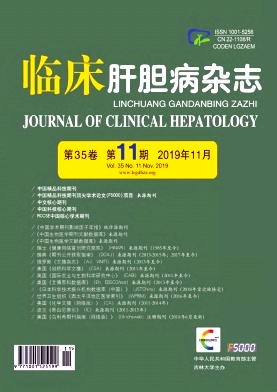|
[1] Chinese Society of Hepatology and Chinese Society of Infectious Diseases,Chinese Medical Association. The guideline of prevention and treatment for hepatitis C:A 2015 update[J]. J Clin Hepatol,2015,31(12):1961-1979.(in Chinese)中华医学会肝病学分会,中华医学会感染病学分会.丙型肝炎防治指南(2015年更新版)[J].临床肝胆病杂志,2015,31(12):1961-1979.
|
|
[2] ZHANG YR,ZHOU N,LI XL,et al. Causes and countermeasures for relapse after drug withdrawal in patients with chronic hepatitis C[J]. J Clin Hepatol,2015,31(9):1434-1438.(in Chinese)张月荣,周宁,李象霖,等.慢性丙型肝炎患者停药后复发的影响因素分析[J].临床肝胆病杂志,2015,31(9):1434-1438.
|
|
[3] ZHOU Y,YE XT,CHEN W,et al. The effects of interleukin-28B gene polymorphisms on antiviral treatment response in patients with chronic hepatitis C[J]. Chin Infect Dis J,2017,35(4):218-222.(in Chinese)周宇,叶晓婷,陈威,等.白细胞介素-28B基因多态性对慢性丙型肝炎患者抗病毒治疗应答的影响[J].中华传染病杂志,2017,35(4):218-222.
|
|
[4] ECHEVERRIA N,CHIODI D,LOPEZ P,et al. IL28B gene polymorphism rs12979860,but not rs8099917,contributes to the occurrence of chronic HCV infection in Uruguayan patients[J]. Virol J,2018,15(1):40.
|
|
[5] TAHERI S,AYGEN B,KORKMAZ K,et al. Characterization of the interleukin-28B gene rs12979860 C/T polymorphism in Turkish chronic hepatitis C patients and healthy individuals[J]. Balkan Med J,2015,32(2):147-155.
|
|
[6] MATSUURA K,WATANABE T,TANAKA Y. Role of IL28B for chronic hepatitis C treatment toward personalized medicine[J]. J Gastroenterol Hepatol,2014,29(2):241-249.
|
|
[7] RANJAN P,FLETCHER J,KADHAKRISHNAN M,et al. Association of interleukin-28B rsl2979860 and rs8099917 polymorphism with sustained viral response in hepatitis C virus genotype 1 and 3 infected patients from the Indian subcontinent[J]. Indian J Med Microbiol,2016,34(3):335-341.
|
|
[8] HOLMES JA,DESMOND PV,THOMOSON AJ,et al. Does IL28B genotyping still have a role in the era of direct-acting antiviral therapy for chronic hepatitis C infection[J]. J Viral Hepat,2012,19(10):677-684.
|
|
[9] CHU TW,KULKARNI R,GANE EJ,et al. Effect of IL28B genotype on early viral kinetics during interferon-free treatment of patients with chronic hepatitis C[J]. Gastroenterology,2012,142(4):790-795.
|
|
[10] POORDAD F,MCCONE J,BACON BR,et al. Boceprevir for untreated chronic HCV genotype1 infection[J]. N Engl J Med,2011,364(13):1195-1206.
|
|
[11] HE YJ,LIU ZH,HOU JL. Selection of direct-antiviral agents for chronic hepatitis C infection[J]. Chin J Hepatol,2018,26(3):169-172.(in Chinese)何雅婧,刘智泓,侯金林.直接抗病毒药物治疗慢性丙型肝炎的方案选择[J].中华肝脏病杂志,2018,26(3):169-172.
|
|
[12] ZHANG Y,LENG XJ,YAN XB. Interaction between anti-HCV direct anti-viral agents and other drugs[J/CD]. Chin J Exp Clin Infect Dis:Electronic Edition,2017,11(2):105-110.(in Chinese)张莹,冷雪君,颜学兵.抗HCV直接抗病毒药与其他药物的相互作用[J/CD].中华实验和临床感染病杂志:电子版,2017,11(2):105-110.
|
|
[13] YOUNOSSI ZM,STEPANOVA M,JACOBSON IM,et al. Sofosbuvir and velpatasvir with or without voxilaprevir in directacting antiviral-naive chronic hepatitis C:Patient-reported outcomes from POLARIS 2 and 3[J]. Aliment Pharmacol Ther,2018,47(2):259-267.
|
|
[14] MARIO S,CARMINE M,STEFANIA D,et al. Virological patterns of HCV patients with failure to interferon-free regimens[J]. J Med Virol,2018,90(5):942-950.
|
|
[15] BERDEN FA,AALDERING BR,GROENEWOUD H,et al. Identification of the best direct-acting antiviral regimen for patients with hepatitis C virus genotype 3 infection:A systematic review and network meta-analysis[J]. Clin Gastroenterol Hepatol,2017,15(3):349-359.
|
|
[16] ZHANG X,LI YG. Current status of the application of directacting antiviral agents in treatment of chronic hepatitis C and existing problems[J]. J Clin Hepatol,2018,34(4):853-857.(in Chinese)张熙,李用国.慢性丙型肝炎直接抗病毒药物应用现状及存在问题[J].临床肝胆病杂志,2018,34(4):853-857.
|







 DownLoad:
DownLoad: